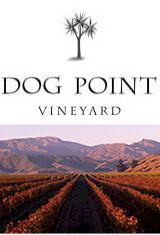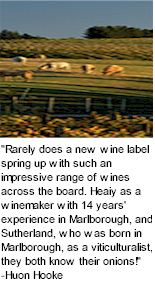


These were days of few fences, of boundary riders and boundary keeping dogs. Shepherd's dogs sometimes became lost or wandered off and eventually bred into a marauding pack which attacked local flocks. These delinquent canines would retreat to a tussock and scrub covered hill which they inhabited, overlooking the Wairau Plains, designated by the early settlers as Dog Point.

The Dog Point region is home to one of New Zealands cultural and ecological treasures, 'ti kouka', commonly known as the cabbage tree. This attractive, distinctive, hardy native New Zealand plant is an aesthetic feature of the Dog Point landscape. Its remarkable natural qualities and strong signature of geographical identity have a synergy with the wines of Dog Point, which are a natural expression of the land from which they are created.
Marlborough's Wairau Valley is the major grape growing region of New Zealand, a confined geographical area at the northern tip of the South Island. Abundant sunshine, low rainfall and cool autumn nights characterise our long growing season, enabling the slow evolution of a rich array of vibrant fruit flavours.
Fruit for the Dog Point wines is sourced from selected vineyard plantings dating back to the late 1970's. These older well-established vines situated on free draining silty clay loams are supplemented with fruit from closely planted hillside vines with a clay loam influence.

Dog Point Vineyard combines the considerable wine-growing experience of Ivan and Margaret Sutherland and James and Wendy Healy. The philosophy at Dog Point involves nothing less tham total involvement by the partners, from the vineyard and nurture of the fruit, through the entire winemaking process, and eventually to marketing the regionally distinctive expressive Dog Point wines.
The estate's premium Cuvée Section 94 is made from Sauvignon Blanc grown to a specific area of the vineyard. The title Section 94 dates back to an early survey of Marlborough, and in particular the subdivision of the vast Hawkesbury Run which at that time encompassed an area of 6878 acres, 7 roods and 5 perches. Wine from this vineyard shows distinctive yellow fruit influence, which together with extended lees contact in older oak barrels produces a wine with considerable texture and flavour. Section 94 is Sauvignon Blanc with a difference.
James Healey and Ivan Sutherland did not leap head first into Dog Point Vineyards and they did not try and expand too quickly at their winery which is best described, Sutherland says, as the bare bones of a building with the best equipment money can buy. In their previous incarnations as winemaker (Healey) and viticulturist (Sutherland) at Cloudy Bay Wines, they learned exactly what money could buy so they figured out what they needed.
They had also secured markets before they began bottling, relying on contacts made over the years in Australia, Britain and the United States. One of the keys to the success of Dog Point Vineyards lies in the vineyard itself, they employ 14 fulltime workers to attend to the pampering needed by their close-planted, low-cropped vines. And though they are producing only 8000 cases a year, they own 80ha of vines and keep up with maintenance costs by selling a substantial proportion of grapes to Cloudy Bay Wines.
